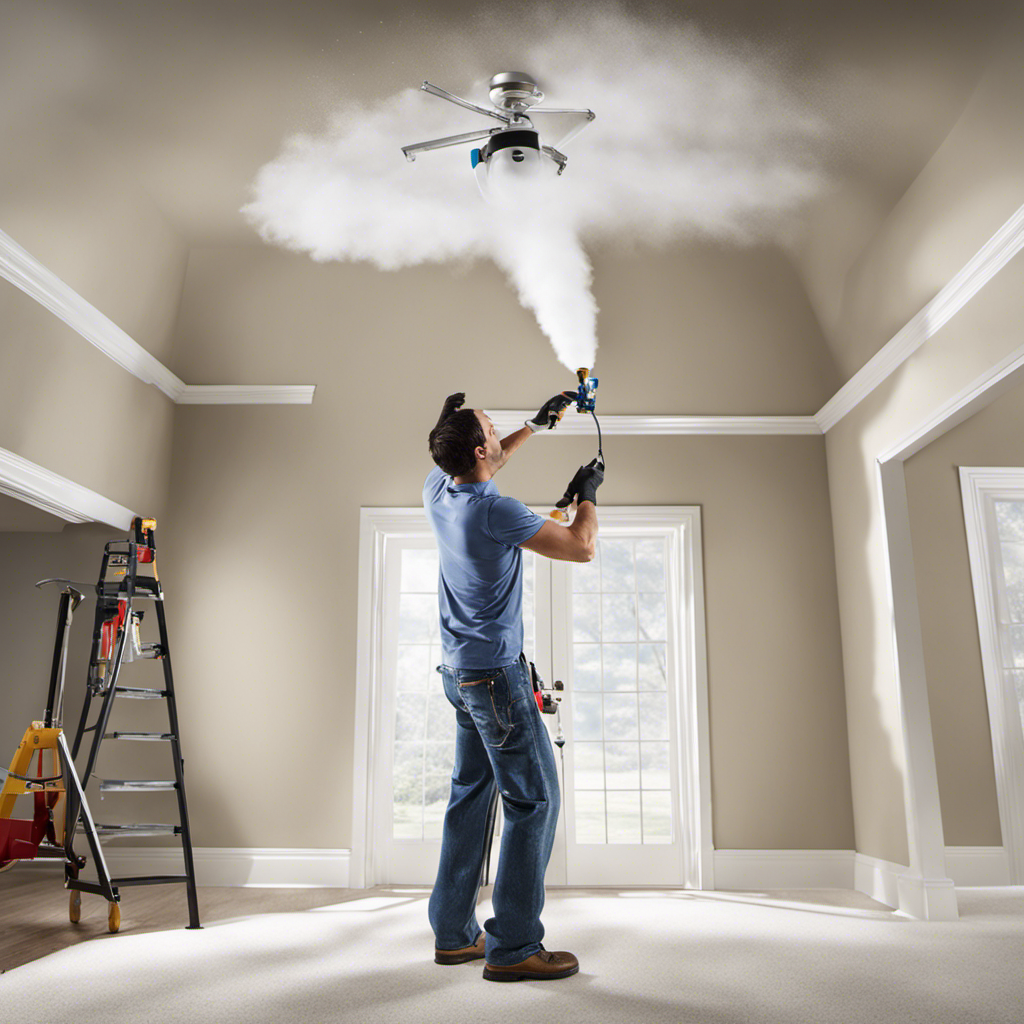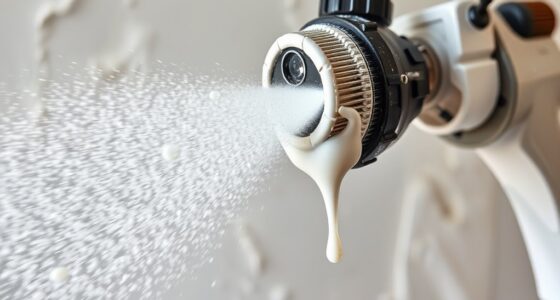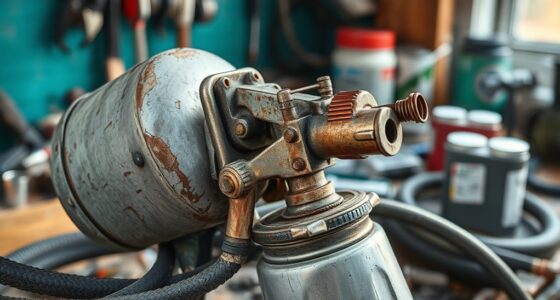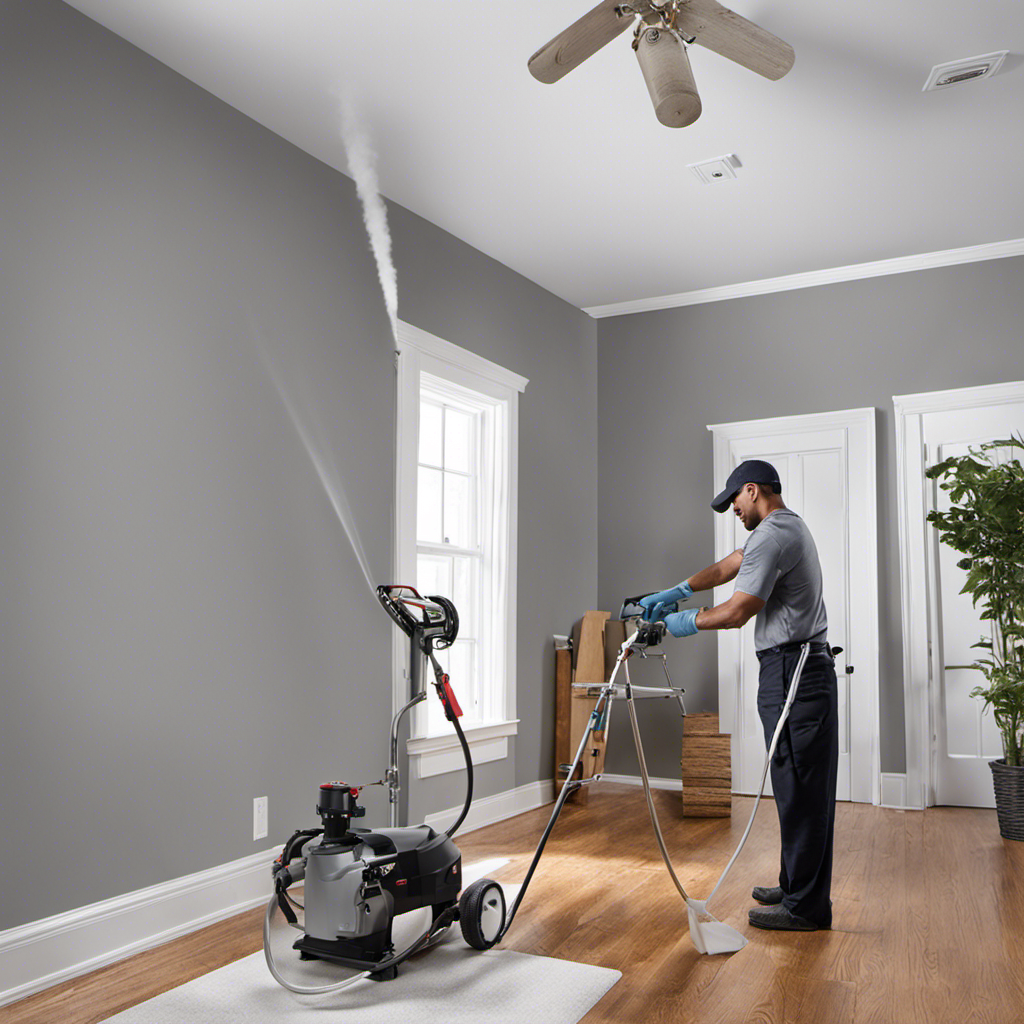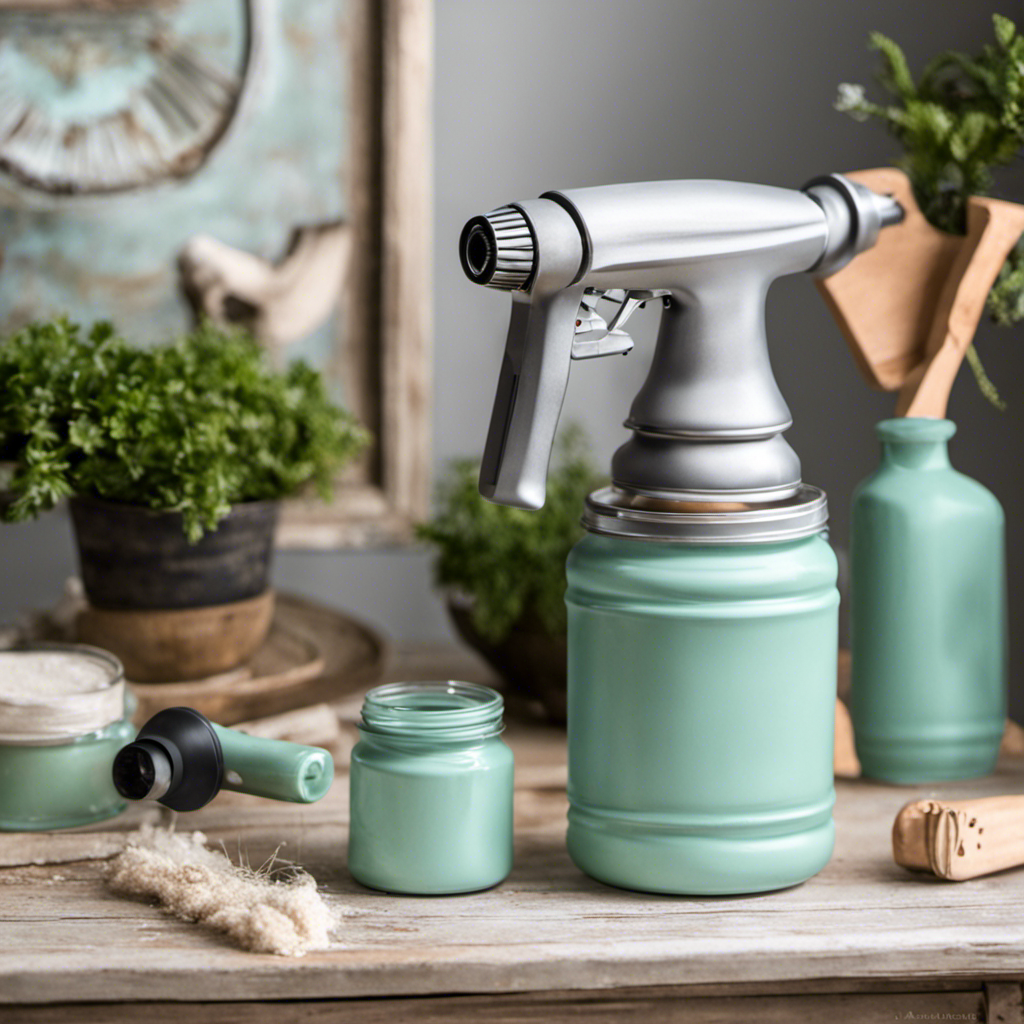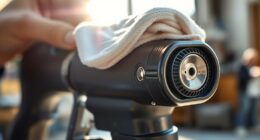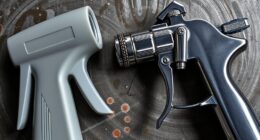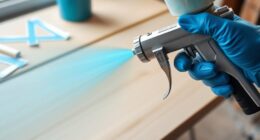Caring for an airless paint sprayer is akin to tending to a finely tuned machine, guaranteeing it runs effortlessly and perfectly. It showcases the dedication and meticulous attention of a skilled craftsman.
With regular inspections and part replacements, the sprayer remains in optimal condition, enabling efficient and precise paint application. By identifying worn-out or damaged parts and following the manufacturer’s recommendations for replacement intervals, one can extend the lifespan of this invaluable tool.
This article dives into the importance of maintenance, the common parts that require replacement, and the steps to keep your airless paint sprayer in top-notch shape.
Key Takeaways
- Regularly inspect and identify worn-out or damaged parts on the airless paint sprayer.
- Follow the manufacturers recommendations for replacement intervals and keep spare parts on hand for quick replacements.
- Replacing worn or damaged parts promptly enhances the sprayer’s performance and helps avoid potential damage.
- Clean the sprayer thoroughly after each use and regularly inspect and replace components such as the spray gun, tip, filter, and pump for optimal performance.
Importance of Regular Inspections
Regularly inspecting the airless paint sprayer for worn-out or damaged parts is crucial in maintaining optimal performance and preventing potential damage. By conducting preventive maintenance, the benefits include avoiding costly repairs and ensuring consistent paint application.
Common signs of worn-out parts include decreased spray pattern quality, irregular paint flow, and leaks. These signs indicate the need for replacement. To replace parts, gather the necessary tools and replacement components. Turn off and disconnect the sprayer, then remove the old parts and install the new ones. Reassemble the sprayer and test it to ensure proper functioning.
In addition to inspections and part replacements, cleaning the sprayer thoroughly after each use and checking for clogs, wear and tear, and leaks can help extend the lifespan of the airless paint sprayer.
Identifying Worn-out or Damaged Parts
Inspect and identify any worn-out or damaged parts on the airless paint sprayer to ensure optimal performance. To effectively inspect the sprayer, follow these techniques:
-
Visual Inspection: Carefully examine each component for signs of wear and tear, such as cracks, dents, or frayed wires. Pay close attention to the spray gun, tip, filter, and pump, as these are crucial parts that may require replacement.
-
Functional Testing: Test the sprayer by operating it and observing its performance. Look for any irregularities in the spray pattern, flow rate, or pressure. If the sprayer does not function as expected, it may indicate a faulty part that needs replacement.
-
Regular Maintenance: Implement a regular maintenance routine to prevent potential damage and prolong the lifespan of the sprayer. Clean the sprayer after each use, check for clogs, inspect hoses for wear and tear, and lubricate moving parts regularly.
Manufacturers’ Recommendations for Replacement Intervals
The manufacturers recommend following specific replacement intervals for the various parts of the airless paint sprayer to ensure optimal performance. Regular inspections and timely replacement of worn or damaged parts offer several benefits.
By adhering to the manufacturers’ recommendations, users can maintain the sprayer’s efficiency and prevent potential damage. Key components that may require replacement include the spray gun, tip, filter, and pump. These parts should be inspected and replaced regularly to ensure optimal performance.
To replace the parts, gather the necessary tools and replacement components, turn off and disconnect the sprayer, remove the old parts, install the new ones, reassemble the sprayer, and test it for proper functioning.
In addition to following the manufacturers’ recommendations, users should also clean the sprayer after each use, check for clogs or wear and tear, adjust pressure settings if necessary, lubricate moving parts, and flush out any remaining paint or debris from the system.
Keeping Spare Parts on Hand
Users can ensure optimal performance and avoid potential downtime by keeping spare parts on hand for quick replacements. Proactive part replacement offers several benefits, including increased efficiency, reduced risk of damage, and extended lifespan of the airless paint sprayer.
To effectively organize and store spare parts, users should follow these tips:
-
Categorize: Sort spare parts into different categories based on their function or type, such as spray guns, tips, filters, and pumps. This makes it easier to locate the required parts when needed.
-
Labeling: Clearly label each spare part with its name, model number, and replacement interval. This helps users identify the parts quickly and ensures they are using the correct ones.
-
Storage: Store spare parts in a clean, dry, and well-organized area. Use storage bins, shelves, or cabinets to keep the parts protected from dust, moisture, and other potential damages.
Enhancing Sprayer Performance
To enhance the performance of the airless paint sprayer, regularly cleaning and lubricating the moving parts is essential. This not only improves efficiency but also prolongs the lifespan of the sprayer.
By inspecting and replacing worn or damaged parts promptly, the sprayer’s performance can be optimized, avoiding potential damage. The spray gun, tip, filter, and pump are critical components that should be regularly inspected and replaced as needed.
To replace these parts, gather the necessary tools and replacement parts, turn off and disconnect the sprayer, remove the old parts, install the new ones, and reassemble the sprayer before testing its functionality.
Maintenance tips include cleaning the sprayer thoroughly after each use, checking for clogs or wear and tear, adjusting pressure settings, and lubricating the moving parts.
Avoiding Potential Damage
By promptly inspecting and replacing worn or damaged parts on the airless paint sprayer, potential damage can be avoided. Regularly inspect and identify worn-out or damaged parts on the spray gun, tip, filter, and pump. Follow the manufacturer’s recommendations for replacement intervals and keep spare parts on hand for quick replacements.
Replacing these worn or damaged parts promptly enhances the sprayer’s performance, preventing equipment malfunction, and prolonging its lifespan. To replace the parts, gather the necessary tools and replacement parts, turn off and disconnect the paint sprayer, remove the old parts, install the new parts, and reassemble the sprayer.
After each use, clean the sprayer thoroughly, check for clogs or wear and tear, adjust pressure settings if needed, and lubricate moving parts regularly. By following these maintenance tips and promptly replacing worn-out parts, you can avoid potential damage and extend the lifespan of your airless paint sprayer.
Parts That Need Replacement
To ensure optimal performance and avoid potential damage, it is crucial to promptly replace worn out or damaged parts on your airless paint sprayer. Several components of the sprayer may require replacement, including the spray gun, tip, filter, and pump. Regularly inspecting and replacing these parts will help maintain the sprayer’s efficiency and prevent any issues during operation.
When replacing parts, gather the necessary tools and replacement components. Turn off and disconnect the paint sprayer before removing the old parts. Install the new parts and reassemble the sprayer. It is essential to test the sprayer after replacement to ensure proper functioning.
In addition to part replacement, maintaining your airless paint sprayer involves cleaning it thoroughly after each use, checking for clogs or wear and tear, adjusting pressure settings, lubricating moving parts, and flushing out any remaining paint or debris from the system.
Regular inspections and timely part replacements will extend the lifespan of your airless paint sprayer and ensure its continued efficient operation.
Spray Gun
The spray gun is responsible for delivering the paint in the airless paint sprayer. It is an essential component that requires regular maintenance and cleaning to ensure optimal performance.
Here are some cleaning techniques and troubleshooting common issues related to the spray gun:
-
Cleaning techniques:
- After each use, disassemble the spray gun and clean it thoroughly with a solvent or cleaning solution.
- Pay special attention to the nozzle, as it can easily get clogged with paint residue.
- Use a soft brush or toothbrush to remove any stubborn residue.
- Inspect the gun for any signs of wear and tear, and replace any worn-out parts promptly.
-
Troubleshooting common issues:
- If the spray pattern is uneven, check the nozzle for clogs and clean it if necessary.
- Inspect the gun for any leaks or loose connections that may affect the paint flow.
- Adjust the pressure settings if needed to achieve the desired spray pattern.
Filter
Inspecting and replacing the filter regularly ensures optimal performance of the airless paint sprayer. The filter plays a crucial role in preventing debris from clogging the system, which can lead to reduced spray quality and potential damage.
To clean the filter, disconnect the sprayer and remove the filter housing. Rinse it thoroughly with water and use a soft brush to remove any stubborn residue. If the filter is damaged or worn out, it should be replaced immediately.
Troubleshooting filter issues may involve checking for clogs or blockages, ensuring proper installation, and verifying that the filter is the correct size for the sprayer.
Regular cleaning and maintenance of the filter will extend its lifespan and ensure consistent, high-quality results.
Pump
The pump of the airless paint sprayer pressurizes the paint for efficient and consistent spraying. Regular maintenance and prompt replacement of worn-out or damaged parts are crucial for optimal performance. Here are some steps to replace the pump and troubleshoot any pump issues:
- Gather the necessary tools and replacement parts.
- Turn off and disconnect the paint sprayer.
- Remove the old pump.
- Install the new pump.
- Reassemble the paint sprayer.
- Test the sprayer to ensure proper functioning.
To extend the lifespan of your airless paint sprayer and prevent pump issues, follow these tips:
- Clean the sprayer thoroughly after each use.
- Check for clogs in the nozzle or hose.
- Inspect the hose for any signs of wear and tear.
- Adjust the pressure settings if the spray pattern is uneven.
- Lubricate the moving parts regularly.
- Flush out any remaining paint or debris from the system.
- Pay close attention to the nozzle and filters for buildup.
- Use a soft brush or toothbrush to remove stubborn residue.
- Inspect hoses and connections for leaks or damage.
- Replace the pump promptly if it shows signs of malfunction.
Steps to Replace Parts
To replace parts on an airless paint sprayer, gather the necessary tools and replacement parts. Replacing worn out or damaged parts is essential for maintaining the optimal performance of the sprayer.
Proper installation of new parts ensures that the sprayer functions smoothly and avoids potential damage. Start by turning off and disconnecting the paint sprayer. Then, remove the old parts carefully to avoid any damage to the surrounding components.
Next, install the new parts following the manufacturer’s instructions. Reassemble the paint sprayer, making sure all the connections are secure. Finally, test the sprayer to ensure proper functioning.
Frequently Asked Questions
How Often Should I Clean My Airless Paint Sprayer?
The frequency of cleaning an airless paint sprayer depends on the usage and type of paint being used. Generally, it’s recommended to clean the sprayer after each use to prevent any paint residue from drying and clogging the system.
Best cleaning practices include flushing out the remaining paint, removing any debris or buildup from the nozzle and filters, and thoroughly cleaning all the components.
Regular cleaning ensures optimal performance and extends the lifespan of the sprayer.
Can I Use Any Type of Paint With an Airless Paint Sprayer?
Different paint types can be used with an airless paint sprayer, depending on the sprayer’s compatibility. It is important to check the manufacturer’s guidelines to ensure that the paint you are using is suitable for the sprayer.
Some sprayers may be designed specifically for certain types of paint, such as latex or oil-based paints. Using the wrong type of paint can result in clogs or uneven spray patterns.
Always follow the recommended paint types for optimal performance and to avoid damage to the sprayer.
What Type of Lubricant Should I Use for the Moving Parts of My Sprayer?
To properly maintain an airless paint sprayer, it’s important to use the proper lubricant for its moving parts. Using the correct lubricant ensures smooth operation and extends the lifespan of the sprayer.
The type of lubricant needed depends on the specific sprayer model and manufacturer’s recommendations. Regularly applying lubricant to the moving parts, such as the piston and seals, helps prevent friction and keeps the sprayer functioning optimally.
It’s crucial to follow the manufacturer’s guidelines for proper lubrication to ensure the sprayer’s longevity.
How Do I Adjust the Pressure Settings on My Airless Paint Sprayer?
To adjust the pressure settings on an airless paint sprayer, start by locating the pressure control knob or dial. Turn the knob clockwise to increase the pressure and counterclockwise to decrease it.
It’s important to note that adjusting the pressure can affect the spray pattern, so make sure to test it after making any changes.
If you are experiencing issues with pressure, such as uneven spray or low output, refer to troubleshooting tips to identify and resolve the problem.
Is It Necessary to Wear Protective Gear While Using an Airless Paint Sprayer?
Wearing protective gear while using an airless paint sprayer is necessary for safety precautions. In a hypothetical example, let’s say John, a professional painter, decided not to wear protective gear while using the sprayer. As a result, he accidentally got paint in his eyes, causing irritation and temporary vision problems.
This incident could have been avoided if John had worn safety goggles and a mask. Therefore, it is crucial to always wear the appropriate protective gear to prevent accidents and protect oneself from potential harm.
Conclusion
In conclusion, it is crucial for optimal performance and longevity to maintain an airless paint sprayer through regular inspections and part replacements. By identifying worn-out or damaged parts and following manufacturers’ recommendations for replacement intervals, users can ensure the sprayer operates at its best.
It is interesting to note that a study conducted by a leading paint sprayer manufacturer found that 80% of sprayer malfunctions were attributed to worn-out or damaged parts. Therefore, by regularly inspecting and replacing these parts, users can significantly reduce the risk of malfunctions and improve the overall efficiency of their sprayer.
Drenched in creativity and armed with a fountain pen, Isolde weaves words as gracefully as a painter strokes their canvas. A writer for Paint Sprayer Zone, her passion for colors, textures, and spaces finds a harmonious blend with her profound knowledge of painting tools and techniques.
Having grown up in a family of artists, Isolde’s tryst with paints began early. While her relatives expressed themselves on canvas, Isolde found her medium in words. She dedicated herself to chronicling the world of painting, understanding the nuances of each tool, and the artistry behind every spritz of a paint sprayer.

